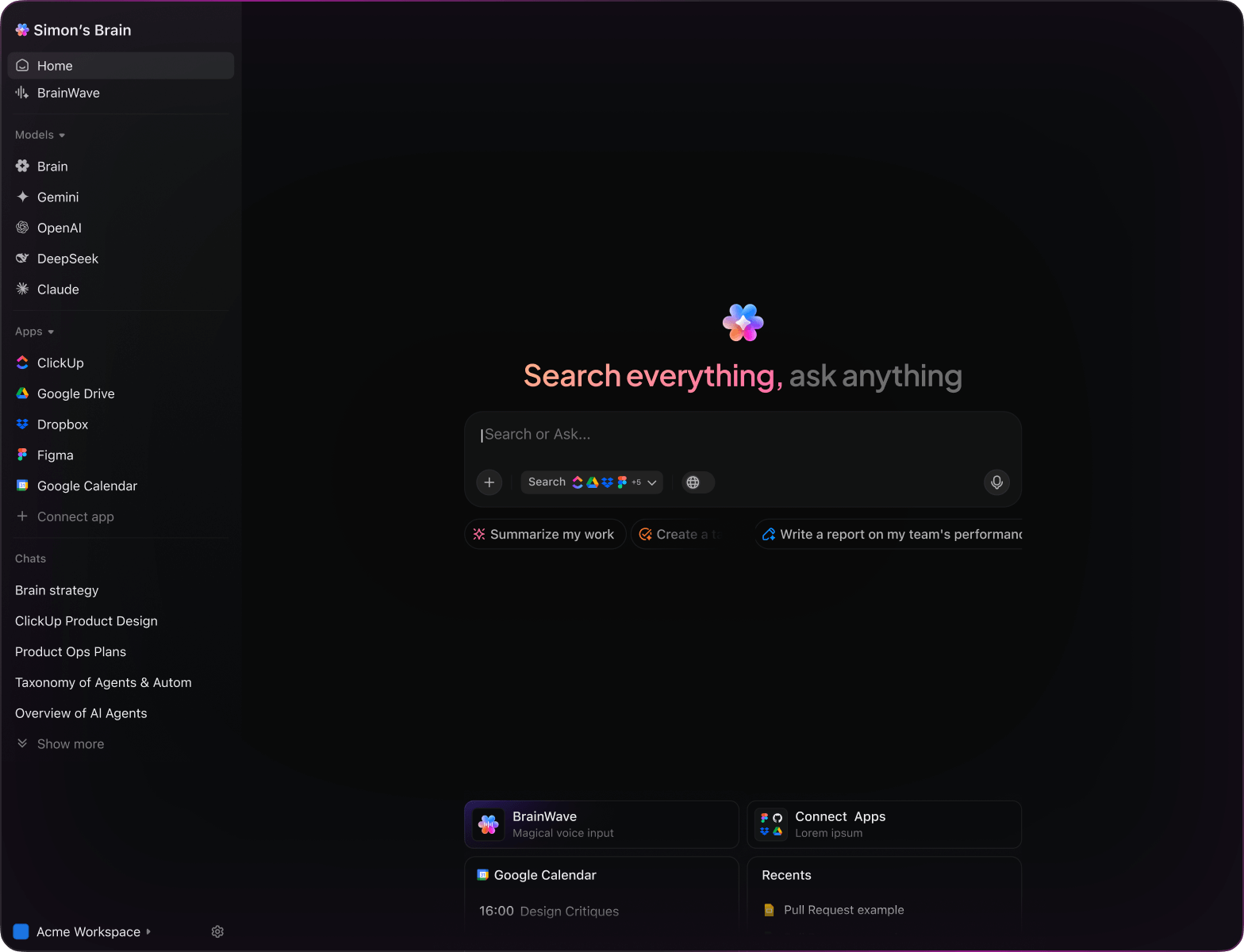AI Virtual Reality Creation
Top AI Prompts for VR Experience Design
Craft immersive VR worlds, optimize your creative process, and elevate your virtual projects using ClickUp Brain.
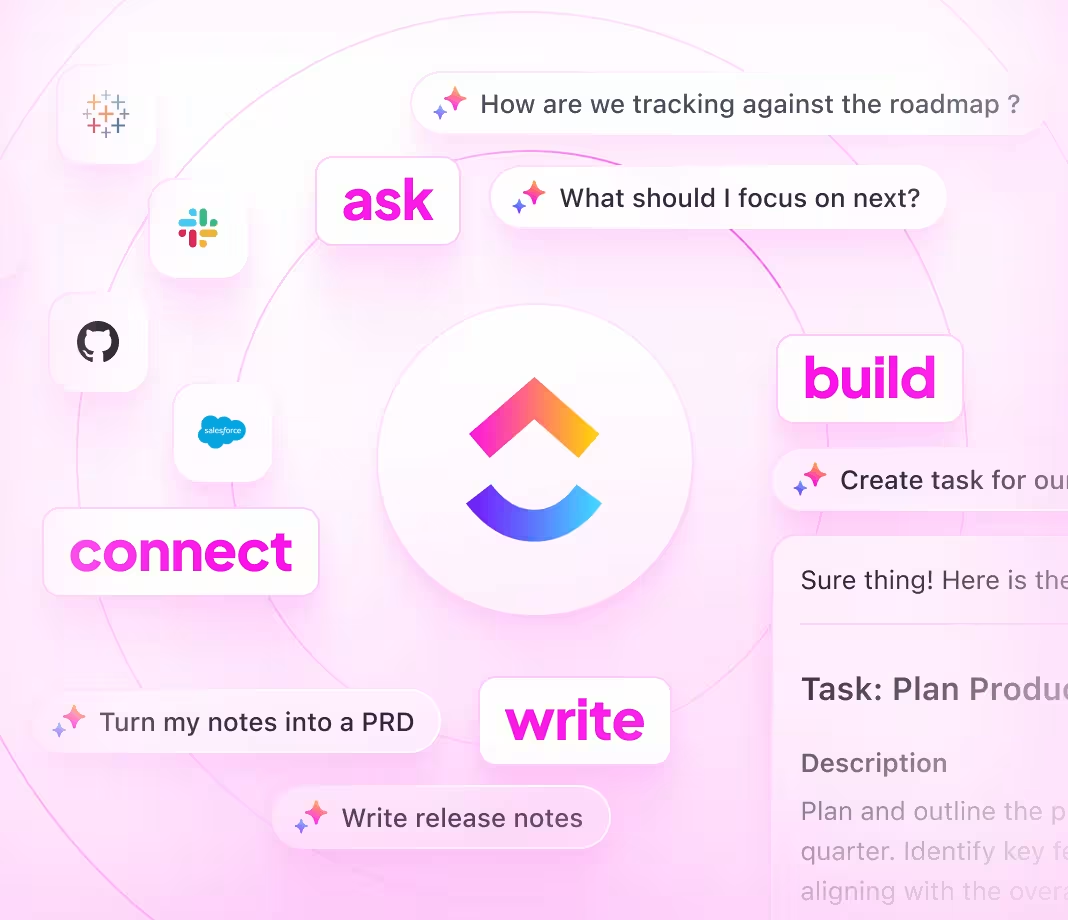
Trusted by the world’s leading businesses
AI in Virtual Reality Development
Revolutionizing VR Experience Creation with AI Prompts
Crafting immersive virtual worlds goes beyond just visuals—it demands seamless coordination and innovation behind the scenes.
From initial concept sketches to environment design, interaction scripting, and user testing, VR development encompasses numerous complex stages—and countless files, prototypes, and deadlines. This is where AI prompts make a significant impact.
Development teams leverage AI to:
- Quickly identify emerging VR trends and design inspirations
- Generate scene layouts, interaction flows, and narrative scripts with minimal input
- Digest extensive user feedback and technical documentation
- Transform brainstorming notes into clear project plans, task lists, or development sprints
Integrated into daily tools like documents, whiteboards, and project trackers, AI evolves beyond a helper. Within platforms such as ClickUp Brain, it actively converts creative ideas into structured, executable tasks.
ClickUp Brain vs Conventional AI
Why ClickUp Brain Stands Out
ClickUp Brain integrates seamlessly, understands your VR projects deeply, and empowers you to focus on creating rather than explaining.
Conventional AI Solutions
- Constantly switching apps to collect project details
- Repeating your VR objectives with every query
- Receiving generic, irrelevant suggestions
- Hunting through multiple platforms for a single asset
- Interacting with AI that lacks initiative
- Manually toggling between different AI engines
- Merely a browser add-on without deep integration
ClickUp Brain
- Instantly accesses your VR tasks, documents, and team notes
- Remembers your past inputs and project goals
- Provides detailed, context-aware guidance
- Offers unified search across all VR resources
- Supports voice commands with Talk to Text
- Automatically selects the optimal AI model: GPT, Claude, Gemini
- Dedicated Mac & Windows app optimized for VR workflows
Virtual Reality Experience Prompts
15 Essential AI Prompts for VR Experience Design
Enhance VR creation—conceptualize, analyze, and optimize with ease.

Identify 5 innovative environment themes for a VR meditation app, drawing from the ‘Zen VR Concepts 2025’ document.
ClickUp Brain Behavior: Analyzes linked files to extract thematic elements and suggests creative environment ideas.

What user interface trends are emerging in VR productivity tools under $50?
ClickUp Brain Behavior: Gathers insights from internal reports; Brain Max can supplement with current market data if accessible.

Draft a design outline for an intuitive VR training module inspired by cognitive load theory. Reference ‘Training Module Sketch #3’ and previous notes.
ClickUp Brain Behavior: Pulls relevant content from linked documents to create a structured design plan.

Compare motion tracking accuracy benchmarks between Oculus Quest 3 and HTC Vive Pro using the ‘Tracking Performance Q2’ report.
ClickUp Brain Behavior: Extracts and summarizes quantitative and qualitative data from internal sources for comparison.

List top materials used in VR headset comfort design, referencing R&D documentation and supplier specifications.
ClickUp Brain Behavior: Reviews internal documents to identify common materials and their performance characteristics.

From the ‘Haptic Feedback Validation’ report, generate a detailed testing checklist for VR controllers.
ClickUp Brain Behavior: Identifies test parameters and formats them into a comprehensive checklist within a task or document.

Summarize 3 emerging interaction patterns in VR social platforms based on post-2024 user studies and technical reviews.
ClickUp Brain Behavior: Extracts key themes and repeated findings from linked research materials.

From the ‘Gen Z VR Usage Survey Q1’ document, summarize main preferences for immersive app interfaces.
ClickUp Brain Behavior: Analyzes survey data to highlight recurring design preferences and user feedback.

Write engaging and concise onboarding text for a VR fitness app, using the tone guidelines in ‘BrandVoice.pdf’.
ClickUp Brain Behavior: References tone documents to propose varied copy options for user interfaces.

Summarize upcoming VR hardware safety standards for 2025 and their implications on headset design.
ClickUp Brain Behavior: Reviews linked compliance documents and provides a clear summary; Brain Max can add public updates if available.

Generate placement and size specifications for VR UI elements, referencing region-specific accessibility guidelines in our workspace.
ClickUp Brain Behavior: Extracts detailed rules and notes from internal documents to create a compliance checklist.

Create a usability testing checklist for VR locomotion mechanics using US ergonomic standards and our design archives.
ClickUp Brain Behavior: Identifies key testing criteria from PDFs and internal folders, organizing tasks by test focus areas.

Compare environmental audio design approaches across leading VR platforms using our competitive analysis files.
ClickUp Brain Behavior: Summarizes documented comparisons into a clear, digestible format (tables or briefs).

What immersive storytelling trends have emerged in VR since 2023?
ClickUp Brain Behavior: Synthesizes trend data from internal research notes, concept overviews, and uploaded reports.

Summarize main user experience challenges reported in Southeast Asia VR feedback folders (comfort, navigation, interaction).
ClickUp Brain Behavior: Extracts and prioritizes user issues from surveys, feedback notes, and tagged support tickets.
Create Virtual Worlds Efficiently with ClickUp Brain
Cut down on revisions, unify your team, and craft superior VR experiences using AI-driven workflows.





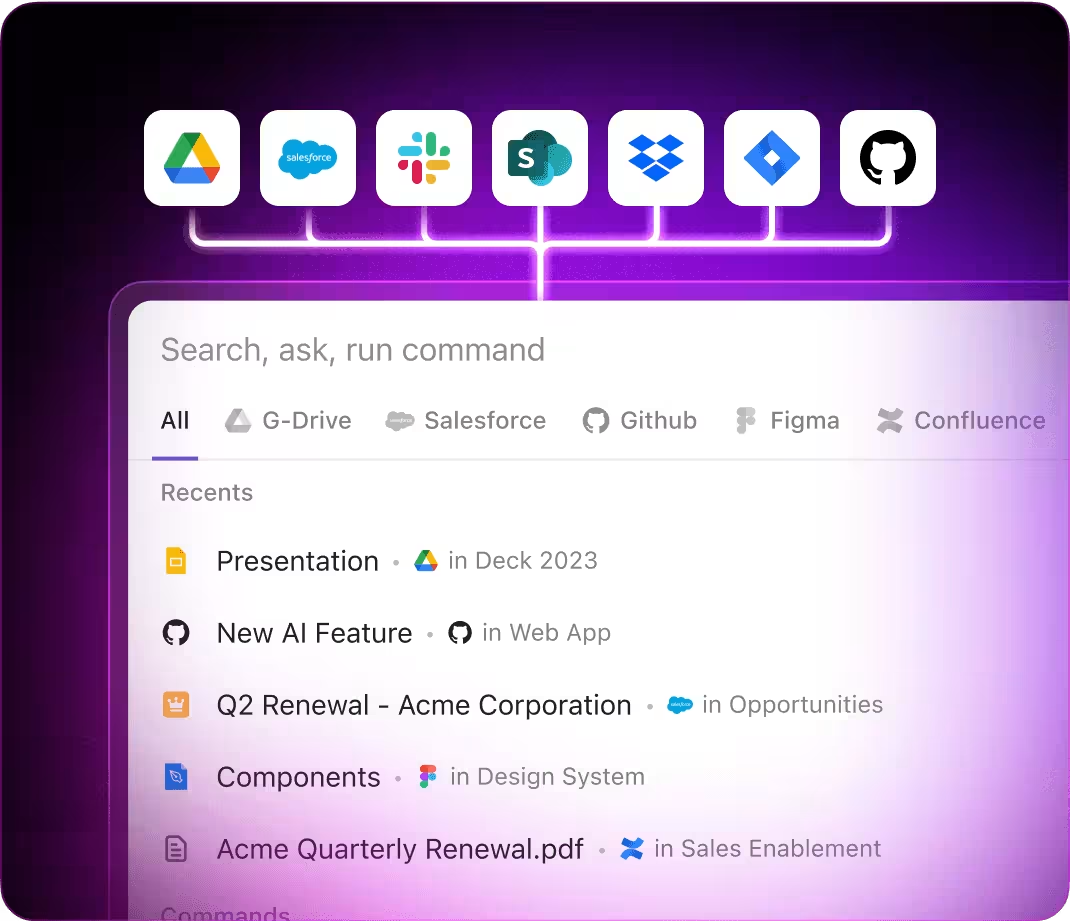
AI Prompts for Virtual Reality Experiences with ClickUp Brain
Discover How ChatGPT, Gemini, Perplexity, and ClickUp Brain Enhance VR Project Workflows
ChatGPT VR Prompts
- Outline a 5-step plan for designing immersive VR training modules focused on user engagement.
- Craft promotional text for a VR fitness app highlighting interactivity and real-time feedback.
- Propose 3 innovative environment concepts for a VR meditation experience emphasizing tranquility.
- Develop a detailed workflow for integrating haptic feedback into a VR game prototype.
- Compare the last 3 VR headset user interfaces and summarize key improvements requested by users.
Gemini VR Prompts
- Generate 3 alternative avatar customization options for a social VR platform based on user preferences.
- List creative lighting schemes for VR environments that enhance mood and immersion.
- Create a mood board description for a futuristic VR workspace highlighting textures, colors, and layouts.
- Suggest ergonomic controller designs for extended VR sessions and rank them by comfort and usability.
- Build a comparison chart for three VR collaboration tools focusing on features, ease of use, and scalability.
Perplexity VR Prompts
- Identify 5 sustainable materials suitable for VR headset production and rank them by durability.
- Compare display technologies for VR devices, emphasizing resolution, latency, and user comfort.
- Summarize emerging trends in VR user interface design and their adoption rates.
- List 5 innovative interaction methods for VR environments and rank them by intuitiveness.
- Analyze previous VR experience designs and extract top 3 lessons for future development.
ClickUp Brain VR Prompts
- Transform this VR user feedback into prioritized design and development tasks.
- Summarize sprint review notes and assign follow-up actions with deadlines and owners.
- Review annotated VR scene drafts and generate a checklist for technical and artistic revisions.
- Compile a task list from cross-department discussions on VR interface enhancements, including priority tags.
- Summarize user testing sessions for VR navigation updates and create actionable bug fixes and design tasks in ClickUp.
How ClickUp Supports You
Transform Initial Thoughts into Polished VR Concepts
- Quickly convert scattered notes into detailed VR experience plans.
- Generate innovative ideas by leveraging data from previous projects.
- Build custom templates to accelerate your VR development cycles.
Brain Max Boost: Effortlessly explore earlier VR designs, user feedback, and creative assets to fuel your upcoming projects.
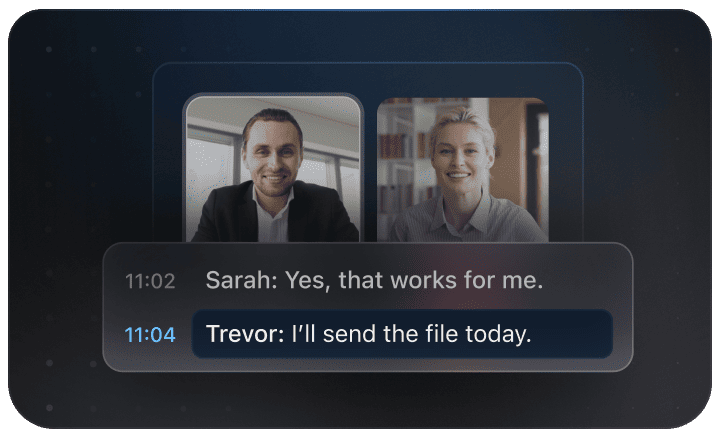
Why Choose ClickUp
Accelerate VR Project Collaboration
- Break down intricate VR design talks into straightforward tasks.
- Transform immersive experience concepts into actionable assignments.
- Instantly produce progress summaries and handoff documents without extra effort.
Brain Max Boost: Quickly access historical VR build insights, asset evaluations, or environment design choices across your projects.
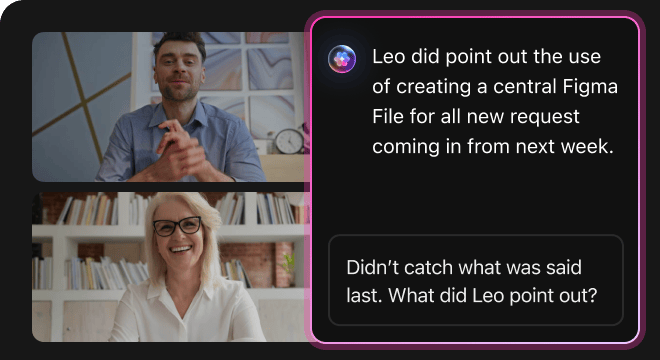
AI Advantages
Harness AI Prompts to Elevate Every Phase of VR Experience Creation
AI prompts accelerate brainstorming and unlock immersive, innovative VR worlds.
Instantly Craft Immersive Concepts
Creators explore daring VR ideas swiftly, enhance creative choices, and overcome development stalls.
Enhance Design Choices with Insight
Make informed decisions, reduce uncertainties, and build VR experiences users and stakeholders appreciate.
Identify Flaws Early to Save Time
Minimizes expensive late revisions, boosts quality, and accelerates launch timelines.
Align Teams Seamlessly Across Disciplines
Improves collaboration, prevents misunderstandings, and speeds consensus among design, development, and QA.
Drive Innovation Beyond Limits
Ignites creative breakthroughs, shapes future VR trends, and keeps your projects pioneering.
Integrated AI Workflows Within ClickUp
Transforms AI-generated ideas into actionable tasks that propel your VR projects forward.
Speed Up Your VR Design Workflow
Cut down mistakes, simplify team transitions, and produce more intelligent results using AI support.





